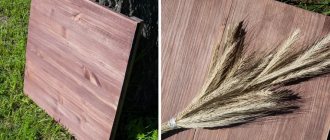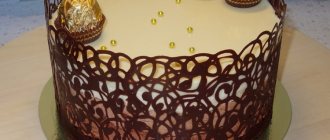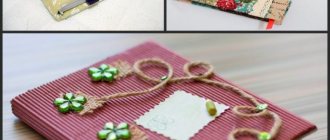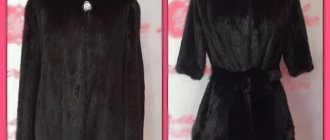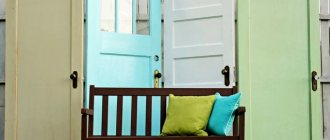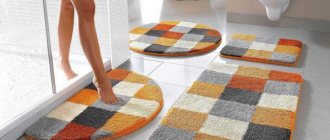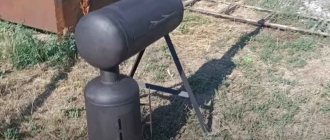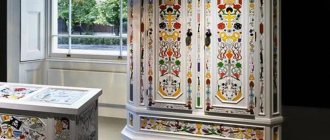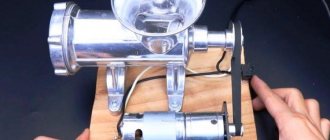How to use leftover laminate flooring after renovation? Most people have to solve this problem after replacing the floor covering. Of course, you can simply store them or throw them away, but there are much more interesting ways to use excess finishing materials. They make excellent kitchen aprons and window trims, shelves and drawers, decorative screens and clocks. And some even manage to decorate the ceiling using laminate. The most interesting ideas on where to use leftover laminate flooring with photo examples and detailed descriptions are collected in this article.
Shelf design: stands and fasteners
The most fun part of this process is planning the contents of your shelf. Here you can give free rein to your imagination, because it can serve as a basis for storing handicraft tools or stationery, flowers, books or toys. Choose what you need and, based on this, select the appropriate fittings.
You can make one or more shelves on the canvas. This will require cuttings of the same laminate. Saw them into pieces of the required length and paint the cuts. For fixation, use corners or stands like these, which can be bought at any furniture fittings store.
By the way, try to choose furniture fittings for the shelf in the same color and style. It will give the product a finished look. And all the hooks and stands are usually attached to bolts. To securely fix all the parts, you will have to drill holes in the laminate. Therefore, prepare a drill with a suitable size drill bit
The author used shelves and hooks of different sizes and shapes for the wall organizer. But note: they are all designed in the same style, and it looks very decent
Kitchen ideas
To prevent the remains of the laminate from gathering dust in the pantry, on the balcony or in the garage, they can be used wisely and profitably. Depending on the amount of remaining material, you can make small or large things: from boxes to pieces of furniture. A laminate apron looks great in the kitchen. This product lasts a long time, and caring for it is very easy.
Creating a kitchen apron from leftover laminate flooring will help save money, protect walls from dirt, and completely transform the room. To arrange it, you need to stick the lamellas on the walls one by one and snap their fastenings into place. In the corners at the joints it is necessary to trim the end locks of the laminate, and then cut holes for sockets.
In addition to the apron, the following kitchen items are assembled from pieces of this material:
- False beam or decorative box. Allows you to hide wires, hide ugly pipes, exhaust system.
- Cutting board. Even one lamella makes as many as 4 boards for cutting food. If you decorate them in different ways, you can make a whole set for working with meat, fish, vegetables and fruits, and bread. True, such boards will have to be washed carefully so that the laminate does not swell from water.
- Hot stand. Thanks to the laminated coating, the product will last for several years. You can place even the hottest dishes on it, because its thermal conductivity is quite low. Making a stand is very simple: just cut out a square or rectangular piece of material with a jigsaw. If you have a special jigsaw file, you can even make a small round stand for a cup of tea and coffee.
- Shelves for kitchen utensils. Before making the shelves, you need to make all the necessary measurements so that the furniture fits exactly in the right place. By the way, on the shelves of the bookcase you can place vases for small items and sweets, which are also made from laminate scraps.
Laminate cutting board
Stationery
The smallest remnants of laminate should also not be thrown away; they can be used for office supplies. For example, it is quite simple to make:
- caskets;
- pencil holders;
- glasses;
- stands;
- boxes and much more.
This is just a small list of options that can be brought to life with a little effort and time.
In order to use the leftover laminate for its intended purpose, it is enough to look around and assess your needs for certain products. Then all that remains is to dream a little, consider ideas and allocate a little time. Flooring residues are not waste, but a necessary material that is used for a variety of purposes.
Crafts
Hand-made lovers probably already know what can be made from old laminate. Even a coating that has already served its useful life, but is still completely intact, can be reused for its intended purpose.
Among the ideas that allow you to use old laminate in a new way, you can highlight the following options:
- Dollhouse. By replacing wooden planks with laminate, you can significantly lighten its design without giving up the traditional design. The house can have several floors, stairs, doors and windows, as well as many other elements necessary for the game. You can do creativity together with your child. For a boy, you can build a fire station from laminate or an entire race track for cars with jumps and pit stops.
- Bird feeder or birdhouse. The planks are environmentally friendly and quite durable; even a schoolchild can make a small house out of them for feathered guests. Don't forget to stock up on slats to connect the parts.
- A house or bed for a cat. There is a huge scope for imagination here. You can create interesting multi-tiered structures with an emphasis on the wall - cats love to move around, make a bed for a furry pet or a secluded refuge for a mother with babies.
- Caskets and boxes. In such structures, made from ordinary laminate, you can easily store sewing supplies or small items. Several products of different sizes can be placed inside each other, like a nesting doll, or placed on a rack or shelf.
- Garbage container. An interesting solution to make the waste storage area more presentable.
- Toy box. It can be hanging or floor-standing, look like a chest with a lid, or resemble a laundry basket. The main thing is that with such an addition to the room, children quickly and easily learn to put their toys back in their place.
- Holder for network extension cable.
This list of ideas for using leftover material for floor finishing does not end there. It is enough to use your imagination to get truly beautiful and functional things.
Decorative screen for heating radiator
By assembling a box from an old laminate or its remains on a frame, you can create a product that simultaneously has an important functional and decorative purpose. When making such a design - a screen, it is enough to fasten the remaining pieces of material together with a locking connection, and then close the ends with strips or self-adhesive tape. The assembled shield is attached to the corner of the window sill.
Laminate screen for decorating heating radiators. The master's mistake was that he did not leave side holes for air.
Using a decorative screen, you can hide any communication elements that do not fit into the design of the room - pipes, radiators, wiring.
Be sure to leave holes for heat to escape. It is better to do this from above and from the side.
Household crafts
Laminate leftovers will definitely come in handy around the house. From them you can build a variety of structures that are so necessary in any home. However, it is necessary to take into account the load-carrying capacity of the material.
For example, a laminate shelf may not be able to support heavy books, but it will be just right for shoes. Home craftsmen create many different simple furniture from laminate scraps.
- Shelves. They can be installed in the country house, and they also look good in the apartment. The design dimensions and shape are selected in random order.
- Old furniture is finished with laminate strips. Mostly country furniture is decorated. The scraps are placed in a chaotic manner to give the furniture a more decorative appearance.
- It costs nothing for a good craftsman to build a table from the remaining laminate. In your apartment you can install a laminate chest of drawers with a large number of different drawers.
- Old batteries spoil the appearance of the interior. They can be covered with a laminate shield. It looks beautiful and harmonizes with the flooring.
Ottoman made from leftover laminate
Mosaic
Often, after repairs, there are pieces of different floor coverings that differ in appearance, color, and texture. They are used to make a mosaic, which is suitable for creating a picture, a functional area or finishing an entire wall. Various interior items are also decorated with mosaics. It is important that all materials have approximately the same thickness and similar technical parameters. Lay out the mosaic in any order on a sheet of plywood, starting from the border. This decor looks very beautiful if its outline is dark and the center is light.
Features of using laminate residues
Laminate flooring is a special type of building material made from high-density fiberboard. Facing films are used as a protective coating. Thanks to this top, the lamellas are distinguished by their ability to withstand heavy loads and mechanical damage. The protective and decorative layer of the laminated coating is not afraid of temperature changes, moisture, and is antistatic. In appearance, laminate is similar to expensive flooring - parquet.
In addition, the popularity of multilayer material is also explained by its relatively low cost. You can use laminate in any room; its design can be very diverse, this also applies to texture. There are options on the market that successfully imitate stone, leather, and tile.
Laminated boards allow you to effectively decorate a wall and make the room cozy and original.
Important! When working with laminate waste, it is better to use a circular saw or jigsaw to obtain an even cut.
Many leftover laminate flooring ideas require joint locks on them. This is especially true for the process of decorating walls, laying mosaic floors or countertops. As an option, liquid nails or ordinary screws can be used to fix laminate waste, if additional wooden blocks are used.
The standard sizes of laminate boards are:
- length 300-1845 mm;
- width 90-330 mm;
- thickness 8 mm.
Advice! If products made from laminate residues will be used in conditions of excessive humidity, for example, as a container for growing flowers, then the inside must be protected with plastic film.
Laminate furniture
Not all home craftsmen consider the opportunity to make furniture with their own hands from leftover laminate flooring. But this material lives up to expectations. Having 1-2 whole packages of lamellas at your disposal, you can make the following from the leftover laminate:
- Wardrobe for the nursery. A lightweight storage system suitable for toys, small books, and clothes. Such a piece of furniture, made in the same color as the floor, looks especially interesting. Drawers, shelves, and lintels are made from the remains of the floor boards. It is better to choose an all-wood frame.
- Coffee table. It also looks impressive in the same color as the floor. To make the entire structure from scraps, you will need a machine that can cut the elements without chipping. It is better to make the legs from solid wood, covering them with lamellas.
- Shoe rack in the hallway. It uses a solid frame, complemented by laminated lintels and a top panel. The shoe rack can be multi-tiered - this will give it additional functionality.
- Wardrobe on the balcony for storing various household utensils.
Beautiful and practical furnishings made from laminate remnants can look no worse than factory ones if you take care of giving them the right shine. All cuts must be as neat as possible. It is better to protect the ends by painting or applying special sealants.
Let's sum it up
You can do a lot of interesting and useful things with leftover laminate flooring. This material has been appreciated by professional decorators, and today it is increasingly becoming an object of interest for home craftsmen. All you need is to use your imagination. Then even the material remaining after the repair will easily become the basis for new design masterpieces.
The more competently you make calculations before purchasing flooring material, the fewer leftovers you will have. On the page, our experts have posted a detailed guide on how to calculate the required amount of laminate so that you can then use it with minimal waste. However, now you know where to put the excess material. Otherwise, you are limited only by your own imagination, which will certainly suggest other ideas for using such a popular, interesting and practical material.
Ideas for using laminate in various styles (photo)
Surprisingly, laminate panels fit into various style trends:
If you want to highlight the country style, then select a darker texture. Preference is given to imitation logs, boards with a pronounced wood structure, natural timber. When high-tech style predominates in a room, pay attention to glossy material options. For modern classics, the most suitable imitation of light noble wood will be
In the eclectic style, various textures and the most unexpected shades can be used. It is important to remain organic and not get too colorful.
Functionalism. The complete opposite of minimalism style
A combination of various elements of several interior design styles and a large variety of decorative moments.
The neutral walls of the living room will be diluted by laminate flooring with the texture of natural wood.
Bright and laconic living room interior in Scandinavian style
- In a room decorated like a Swiss chalet, laminate flooring with imitation walnut and ash will look good. If preference is given to a pleasant, elegant Provencal style, then light, discreet finishing colors will be required, for example, bleached oak.
- In the Japanese style, muted accents look organically, which help emphasize minimalism in the overall interior design, elegance and restraint. There should not be more than three shades here. Preference is given to gray color.
The color and texture of natural wood in the interior will transform any room
Dark tones of laminate on the wall are best used in spacious rooms
The pop art style, which tends towards maximalism, dynamism, and audacity, allows you to pay attention to the laminate with green splashes and a blue background. This material will harmonize well with the bright patterns of creative furniture. With an avant-garde interior solution, you can use rich shades in wall decoration
Achromatic black and white options will also fit. For the Art Nouveau style, beige or mustard tones are selected. If possible, use plant imitation. The modern version of the Art Deco interior involves broken lines, so the laminate is selected with a similar solution.
Interesting design of a large living room with natural finishing materials
Eco style is popular among people of any age category and with various interests. Natural materials, living plants and flowers soften the bustle of the city
Mediterranean notes in the design of the premises are combined with appropriate bluish and purple shades. Imitation of pebbles and sand is possible.
Video
You can learn in detail how to make a laminate table from the video:
Another useful product made from laminate is a wall clock. How to make them? You will get the answer to this question in the video:
P
After repairs, there are often surplus building materials that you want to use so that they do not go to waste or go to waste. One of these materials is laminate - it is durable, but easy to use and it is a shame that such a building material will go to waste. As a rule, laminate is used in laying floors, but this is far from its only use, which is very important for those who have an abundance of this material. So how else can you use leftover laminate flooring?
From the remaining laminate with your own hands
you can make a bunch of useful and beautiful things and household items.
- flower pots;
- boxes for home mini-gardens, seedlings;
- shelves;
- toy furniture;
- tool boxes, etc.
All this can be easily created from the remains of this material. To provide additional protection from moisture, the inside of the products must be covered with polyethylene or other moisture-proof film. You can also put together boxes for storing some vegetables, to which you should also add a lid. Such a product is also useful simply for storing some things: children's toys, out-of-season shoes, tools.
If there are small scraps of laminate left, they will be suitable for stands for mugs and glasses or for hot dishes. You just need to cut a square or any other shape of a suitable size from an existing piece of laminate and use the resulting result for its intended purpose.
Long boards can be used as light shelves. Of course, they are not suitable for any things, because laminate is a lightweight material and can bend. But for light items, such shelves are quite useful - you can put keys, a small souvenir or a candle on them.
Crafts from leftover laminate
From the remains of laminate you can make not only light products, but also quite useful and strong things. For example, you can build a panel for radiators. Unfortunately, not all of them have a great design, so this decorative laminate panel will come in handy. And besides, this product will completely blend with the floor and not stand out from the overall scheme of the interior.
Laminate can be used quite creatively. For example, why not build a cat house from leftover laminate flooring
? Cat owners know how these furry animals love to hide in secluded places, which means this will be a great gift for their beloved pet. You need to cut out a door and a couple of windows in the house, but it is best to upholster the inside and outside of the house with a special material that will be convenient for the animal to sharpen its claws on. And in the absence of a cat, you can build a house for a child, supplementing it with children's furniture, also made of laminate. You can make a birdhouse or bird feeder.
Since we're talking about furniture, we can start making crafts that are more complex than a children's chair or shelf. From the remains of laminate, some manage to make quite strong stools, shoe racks, or use the material for decorating or finishing old furniture, although such delights are not suitable for every interior.
What else unusual can be made from laminate?
Finish the walls!
Yes, yes, laminate can be used on walls too! You can use solid boards and attach them additionally to the wall with screws, or you can make a decorative panel from various scraps of laminate. For example, if you cut equal rectangles from boards and fold them in a herringbone pattern, and then frame the composition, you will get an impressive and stylish decorative panel that can be hung like a picture. And the remains of the board left over from the craft should also be used: assemble a small box, glue another, but small panel, use it in the decor of some things. The scope for imagination is limitless;
you can make anything you can think of with your own hands from leftover laminate flooring After this, there will simply be no deposits of unnecessary laminate left!
Interior decor
When thinking about what kind of decor can be made from leftover laminate flooring, do not forget about the versatility of this material. It’s easy to add originality with it:
- old fireplace;
- headboard;
- table;
- closet;
- children's furniture;
- fill the void on the wall.
A practical and inexpensive laminate can be used to decorate the podium on which furniture is installed, as well as any other architectural structures in the interior of a house or apartment.
Wall or ceiling finishing
Communication elements often disrupt the overall harmony in the interior. But they can be easily hidden behind decorative cladding by making a laminate box on the ceiling. This design can be the same color as the floor or contrasting, as well as the color of the ceiling beams. Sometimes false boxes are even built, especially when it comes to country or eco style.
It is very convenient to use leftover laminate flooring to decorate the ceiling, walls and floor on the balcony. There is a whole article on how to do this on our website: .
The material remaining after the repair is easily collected by connecting it into a groove. In addition, if you cover part of a wall or ceiling with it, you can get a fashionable space zoning effect. This design solution is well suited for a kitchen-dining room or bedroom with a boudoir area. The space above a makeup table, dressing room or rest area looks good in a contrasting design.
Hanger
If there are few boards left, you can use a piece of laminated fabric as the base for a hanger in the dressing room or hallway. It can be given a curly shape, and then hooks for clothes can be attached to the surface. Traditional wood colors go well with brass and bronze fittings.
Watch
An original idea for decorating a room - a clock made from leftover laminate flooring with your own hands. Here you can use the mechanism from any old alarm clocks, including battery-powered ones. The main block is mounted on the back wall of the dial; a hole is drilled in the center to fix the hands. Clocks from the remnants of the laminate can be made into hanging or floor-standing ones, or given a round or square shape. The options that use strips of 2 colors look interesting. You can also make a new frame for an old watch from the remnants of the laminate, giving it originality.
Housekeeper
A handmade key holder made from leftover laminate flooring is suitable for use in the hallway. It is cut out from a single piece of material, attached to the wall along with hooks, or on hanging corners. To ensure that the material is not afraid of moisture, the ends of the key holder are painted or varnished.
The presented examples show how great a laminate key holder, decorated using the decoupage technique, can look.
Panels and mosaics
An unusual laminated panel can become a central element in the design of a wall or partition in a room. The decor from laminate scraps here can be abstract or have a clear pattern. Laying with herringbone, diamonds, and checkerboard patterns is often used, and having several colors of material at your disposal, you can get a really interesting result.
When very small scraps of laminate flooring remain: what can you do with them? From pieces, including irregular shapes and different colors, you can assemble an original decorative element. Mosaic design is suitable for the central part of the floor or a niche in the wall; it can be used when decorating individual areas. A motley insert of pieces of irregular geometric shapes will diversify the traditional design and give it originality.
Photo background
Beautiful photos, of course, require the skill of a photographer, but lighting, good technique, and background also play a significant role. There are companies that create and sell homemade photo backgrounds, but they are often too expensive and there is simply no money to purchase them. Making a photo backdrop from leftover laminate will be much cheaper and not at all difficult. So, let's look at the step-by-step procedure.
Preparation
To make a photo backdrop from laminate, you will need:
- six laminate scraps, at least 50 cm long;
- double sided tape;
- thick cardboard;
- instant glue;
- jigsaw;
- fasteners - furniture hinges;
- respiratory protection, gloves;
- acrylic paint, tools for painting.
After preparation, you can start working on our background.
Steps:
- First of all, let's fasten our three parts on the back side using double-sided tape, leaving one part of it taped. We will do similar work with three other parts.
- The next step is to mark all the irregularities, saw them off so that in the end we get identical rectangles from one and the second part.
- Next, our parts can be painted in the required color, or if the color of the coating suits you, you can leave the laminate with its original pattern and texture.
- After painting, you need to wait for the surface to dry completely and glue thick cardboard to the back of each of the parts according to their size.
- We secure our rectangles with furniture hinges and now the folding photophone can be tested. The main thing is don’t forget about light and good equipment.
But this is not the only option for using laminate scraps. You can also make interesting boxes that will fit exactly into the color scheme of the room.
Decorating the window
You will be surprised, but with the remains of the laminate you can decorate the window and radiators. To do this, the surface of the window slopes is finished with laminate, the window sill is carefully decorated, and a solid board is attached to it. Do not forget that before work it is necessary to carry out dismantling work. It is necessary to remove the old slopes, clean them, fill the free space with foam, if any, and only then begin finishing work. As a result, you will get a stylish window opening that will be in complete harmony with the floor covering.
It is worth mentioning separately that waste from laminated boards can be used as a screen for heating devices. Thanks to this method, you can hide ugly radiators and pipes that spoil the appearance of the renovated room. In addition, such a screen can protect small children from a hot heating device. Don’t forget the important point that when connecting boards, you need to make holes at the bottom or top so that air can circulate freely and warm the room.
Mounting methods
Installing laminate on the wall differs from the method of laying it on the floor. The main difference is the lack of a single technology. Various options for fastening panels are allowed. The main condition is strength and reliability of fixation on the supporting plane or structure.
The main condition is to provide thermal gaps that compensate for the expansion of the lamellas when heated or absorbing atmospheric moisture. Seasonal expansion of the laminate noticeably changes the linear dimensions of the material. If the cladding is made too tightly, when the composition of the air changes, the canvas will begin to swell and the joints will break down. The entire surface may lose its decorative value and will require replacement.
There are different ways to install laminate panels. Let's take a closer look at them:
Without sheathing
Installing laminate flooring without sheathing is the most popular installation method. It allows you to save the volume of the room; you can subsequently install wall furniture on the paneling, hang sconces or paintings in the usual way. The only limitation is the condition of the surface. If the wall is uneven, full of waves or completely crooked, the adhesive joint will not be able to provide sufficient strength.
With lathing
Lathing is a system of planks installed on the wall perpendicular to the intended direction of laying the panels. It allows you to cover uneven walls that are full of dents. No preliminary preparation is needed in this case. The lathing is installed so that the surface of the planks forms a flat vertical plane.
The disadvantages of this method are:
- due to the additional operation, the installation time increases;
- costs for wall cladding increase;
- the bearing surface of the canvas is limited.
If you plan to hang shelves, lamps or other objects, it is necessary to install mounting platforms in advance. They must be rigidly fixed to the wall, and the surface is located in the plane of the sheathing strips. Once installed, the laminate panels fit snugly into the mounting pads, allowing you to attach wall items in the usual way.
Using clamps
The clamps provide some movement of the panels, which allows the canvas to maintain its flatness during seasonal changes in size. Outwardly, they look like metal plates with a bent edge. The plate is screwed to the sheathing, and the edge presses against the bottom of the connecting groove. The next panel closes the clamp and is fixed to the sheathing in the same way. The principle is simple, installation is quick. However, this requires a wooden base - a lathing or a wall. If the base is brick, then under each fastening element you will have to drill and insert a wooden plug, which will delay the installation for a long time.
Bonus: furniture restoration
Old furniture, especially in the country, can be quite easily updated using laminate. It is enough to fix the new panels on top of the worn surface of the furniture. The most important thing is that after such “modernization” the furniture will retain its strength and durability.
Continuing the theme of any person.
P
After repairs, there are often surplus building materials that you want to use so that they do not go to waste or go to waste. One of these materials is laminate - it is durable, but easy to use and it is a shame that such a building material will go to waste. As a rule, laminate is used in laying floors, but this is far from its only use, which is very important for those who have an abundance of this material. So how else can you use leftover laminate flooring? From the remaining laminate with your own hands
you can make a bunch of useful and beautiful things and household items.
- flower pots;
- boxes for home mini-gardens, seedlings;
- shelves;
- toy furniture;
- tool boxes, etc.
All this can be easily created from the remains of this material. To provide additional protection from moisture, the inside of the products must be covered with polyethylene or other moisture-proof film. You can also put together boxes for storing some vegetables, to which you should also add a lid. Such a product is also useful simply for storing some things: children's toys, out-of-season shoes, tools.
If there are small scraps of laminate left, they will be suitable for stands for mugs and glasses or for hot dishes. You just need to cut a square or any other shape of a suitable size from an existing piece of laminate and use the resulting result for its intended purpose.
Long boards can be used as light shelves. Of course, they are not suitable for any things, because laminate is a lightweight material and can bend. But for light items, such shelves are quite useful - you can put keys, a small souvenir or a candle on them.
Crafts from leftover laminate
From the remains of laminate you can make not only light products, but also quite useful and strong things. For example, you can build a panel for radiators. Unfortunately, not all of them have a great design, so this decorative laminate panel will come in handy. And besides, this product will completely blend with the floor and not stand out from the overall scheme of the interior.
Laminate can be used quite creatively. For example, why not build a cat house from leftover laminate flooring
? Cat owners know how these furry animals love to hide in secluded places, which means this will be a great gift for their beloved pet. You need to cut out a door and a couple of windows in the house, but it is best to upholster the inside and outside of the house with a special material that will be convenient for the animal to sharpen its claws on. And in the absence of a cat, you can build a house for a child, supplementing it with children's furniture, also made of laminate. You can make a birdhouse or bird feeder.
Since we're talking about furniture, we can start making crafts that are more complex than a children's chair or shelf. From the remains of laminate, some manage to make quite strong stools, shoe racks, or use the material for decorating or finishing old furniture, although such delights are not suitable for every interior.
What else unusual can be made from laminate?
Finish the walls! Yes, yes, laminate can be used on walls too! You can use solid boards and attach them additionally to the wall with screws, or you can make a decorative panel from various scraps of laminate. For example, if you cut equal rectangles from boards and fold them in a herringbone pattern, and then frame the composition, you will get an impressive and stylish decorative panel that can be hung like a picture. And the remains of the board left over from the craft should also be used: assemble a small box, glue another, but small panel, use it in the decor of some things. The scope for imagination is limitless, from the remains of laminate with your own hands
you can do anything you can think of! After this, there will simply be no deposits of unnecessary laminate left!
When laying a laminate floor is completed, both whole laminated panels and scraps will remain. If there are enough of them left (we don’t consider the necessary supply for possible repairs), you can find a worthy use for them. What can you make from laminate scraps with your own hands? Beautiful and necessary items that are needed either in the economic, practical sphere of life, or will become decorative items, will decorate the interior of your home.
Accessories for children's games
Only real specialists and craftsmen will be able to make a real miniature house from laminate with their own hands. This product is one of the most complex. It is important to think through everything down to the smallest detail. It should contain elements such as:
- doors;
- window;
- benches;
- fireplace;
- table.
This element will be dangerous to the child’s life due to the sharp corners of the boards. To avoid this, you will have to cover everything with felt. It is also advisable to upholster the inside of the house with soft material, the same felt or thin foam rubber. For fixation, you can use PVA glue or a construction stapler.
To fill the resulting house with all the accessories, you can connect the child and use other, safe materials, for example:
- cardboard;
- colored paper;
- paints;
- textile;
- foil.
As a result of time-consuming and painstaking work, you can get a real house from your child’s favorite fairy tale or cartoon. Each element will be thought out and taken into account, which will allow the child to come up with a variety of games and, importantly, study everyday life and develop fine motor skills.
Advantages and disadvantages of laminate countertops
The main advantages of laminate countertops are as follows:
- By comparing prices for different countertops, buyers are convinced that laminated countertops are cheaper. This is understandable; inexpensive components are used in their manufacture, and this determines affordability;
- It’s easy to keep your countertops clean; just periodically wipe all surfaces with a damp cloth. To remove stains from the material, stain removers and cleaning solutions are used;
- the manufacture of laminate countertops can be made in different shapes; during manufacturing, you can join individual elements and get one that cannot be made by casting;
- laminate is durable; with proper and timely care, countertops of this type can be used for more than ten years. The presence of protective components in the structure of the laminate allows it not to lose color saturation during prolonged exposure to sunlight.
Countertops in the kitchen
Unfortunately, such countertops also have certain disadvantages:
- Laminate does not withstand prolonged heating well. If heat during its production gives the surface the desired rough texture, then hot objects left on the surface can also leave a mark. Therefore, to prevent thermal damage to the material, you need to place hot dishes on the stove using heat-protective supports or stands. For most users, this is a simple requirement; the habit of using stands is developed from childhood;
- laminate is a moisture-resistant material, but prolonged moisture has a negative effect on the surface. The fact is that there are always microcracks that are invisible to the eye. Moisture penetrates through them into the countertop. Accumulating in depth, it causes the chipboard or other material inside to swell. Further delamination of the material is possible;
- Some craftsmen, when joining the tabletop, allow for small differences in size or height. These shortcomings will appear during further use of the tabletop. Therefore, competent craftsmen and quality control workers check the laminated surface with a special palpation. Take a piece of paper and place it under your finger. Run your finger along the surface through the paper. It turns out that receptors sense unevenness through paper better than through direct contact with the surface.
There are not many shortcomings, they are easily eliminated. Laminate countertops are a very interesting solution for a modern kitchen.
average rating
more than 0 ratings
Share link
Designer crafts
But this is not all the ideas that can be realized with the help of leftover floor coverings. You can prove yourself as a real designer and make unique things that will delight not only the guests of your apartment, but also the children. For girls you can make a real dollhouse. The finished product will definitely delight your child, as you will make the dream of most girls come true
It is important that this product is safe for the child, so it should not contain parts that can injure:
- Sharp corners;
- Hard elements that can cause injury;
- Toxic materials (for example, it is better to choose PVA glue, it is safe and does not have an unpleasant odor).
It is necessary to decorate the dollhouse both inside and outside with soft elements:
- Textile;
- Felt;
- Foam rubber;
- Cardboard
If you want to please your significant other or mother or grandmother, then try making a beautiful box from leftover laminate flooring to store jewelry, costume jewelry, or even the family budget. The box can be made in the form of a regular box with a lid. If possible, line the inside with soft fabric, such as velvet or faux suede. Decorate the top with buttons or glue a few coins.
Many people use laminate boards as a stylish decoration for walls and ceilings. Thanks to this method, you can easily divide any room into zones, dividing it into several small spaces. This technique is often used in the bedroom and kitchen, for example, to separate the work area from the eating area or the work space from the rest area. When using flooring on the wall, you get perfectly flat and smooth surfaces. In such cases, laminate flooring with imitation of natural wood is often used, which adds elegance to the room and makes the room feel homely.
If you want to surprise your guests and friends, make a wall panel out of these boards. Let your imagination fly and you will get a real work of art. It could be a mosaic of pieces of different textures or some kind of geometric pattern. If desired, you can apply a design with paint or use photo printing, which is now a very fashionable trend in modern decor. Place your panel in a wooden frame and decorate an empty wall in your apartment. You can also use panels in the form of a triptych and a diptych, placing them sequentially in the room.
If you are into photography, shooting in a photo studio, then a photophone can be very useful to you. It can be of absolutely any size depending on your needs. The most popular now is aged wood, with faded paint, scratched. It's not difficult to do. All you have to do is connect the boards together, scratch them a little and apply acrylic paint to the surface, let it not dry completely and “remove” the paint in several places with a sponge or cloth. In addition, you can combine different laminate textures to give a certain individuality to the background.
Very often, needlewomen resort to this technique. They photograph their work on small photo backdrops imitating natural wood or stone, so the work looks impressive and sells faster.
We have told you only about a few options for using leftover laminated surfaces that are easy to use in life.
To learn how to make a shoe rack from leftover laminate that will decorate your interior, watch the following video.
Panel
Using your imagination, you can make a stylish designer item. For example, laminate is used to create interesting wall panels. Such paintings look harmonious when the shade and texture match the floor covering or have a contrasting color. For large panels, solid lamellas are used, which are laid in a horizontal or vertical direction. The choice of arrangement of elements depends on the size of the room: in small rooms, panels with horizontal laying look better, in large rooms - with vertical laying. For rooms with low ceilings, you should choose a product that is slightly below the ceiling.
Wall panel made from small pieces of laminate
Laminate panels can be original in appearance. For example, individual elements are arranged diagonally, in a herringbone pattern, in a checkerboard pattern, like parquet. This type of work will require more patience and accuracy, as well as a significant amount of laminate. If desired, a drawing is applied to the finished panel with paints or photo printing is done in a special studio, and then it is placed in a frame.
Shelves made from laminate scraps
Shelves have long been used to add functionality to the interior. They were mounted on walls, placed on the floor or suspended from the ceiling. In addition to various methods of fastening, a variety of materials were used for decoration: wood, stone, metal. Modern construction technologies have significantly expanded this list. Although laminate is not a material intended for furniture production, it can still be used to make room interior elements.
Required tools and materials
Laminate is an easy-to-process material. It is made from sawdust held together with moisture-resistant glue. However, the specific fibrous structure imposes restrictions on the use of fasteners - self-tapping screws tear the panels and cannot provide reliable fixation. To make a neat shelf, you need to have on hand:
- A hacksaw for wood or metal. It will take longer to cut the laminate last, but the edge at the cut site will be smoother.
- Screwdriver or drill.
- Wood jigsaw.
- Sander or plane (manual or electric).
- Wood glue or any other suitable for working with fibrous materials.
- Fastening hardware.
Hanging shelf
The simplest option for making a space “expander”. The idea behind the shelf is to hang a length of laminate on ropes or ribbons. In this case, the design can be either single- or multi-level. The first option is a straight strip of laminate suspended from the wall. The floor covering is processed only from the ends to remove the interlocking joints. A multi-level shelf must be drilled in the corners. Ropes are threaded into the holes made to secure the plates in a horizontal position.
Frame
The rigid design of the shelf is more complex in design, but it can withstand the weight of a load placed on it up to 20 kg. Its dimensions depend on the purpose and free space where they plan to hang it. The structure consists of a horizontal shelf, a vertical base and two supporting brackets. Work progress:
- Cut two laminate plates of equal length. The ends of the blanks are processed and covered with decorative tape.
- Make side supporting walls. The figured pattern is cut out with a jigsaw.
- The long plates are connected in a T-shape, leaving 3-4 cm at the bottom. The joints are coated with universal glue. At the joints, to strengthen the structure, they are fixed with self-tapping screws.
- Install the sidewalls (coating them with glue and fastening them with screws).
- Holes are made in the upper part of the shelf for mounting it on the wall.
For books
Laminate can be used to make an excellent shelf for books or magazines. However, in order for the structure to withstand a lot of weight, a higher grade material should be used. If the strength of the strips is not enough and they bend under the weight of books, you can glue two pieces of laminate together. Assembly sequence:
- Cut two vertical and horizontal pieces. They are processed along the perimeter with a plane to remove the “locks”.
- Prepare additional brackets to strengthen the structure. They are made from wooden blocks or metal corners. The length of the brackets is equal to the width of the shelf.
- Connect the laminate pieces into a rectangular structure. Brackets are placed in the corners. All mating surfaces are lubricated with glue and fastened with self-tapping screws.
DIY computer desk
Let's make a computer desk from an old cabinet. I updated the furniture, instead of the old, Soviet wardrobe, I installed a wardrobe with sliding doors.
The old cabinet turned out to be unnecessary, so I dismantled it and took it to the workshop. As we usually think, it may still be useful. Already there I examined the parts carefully, and it turned out that the quality of the parts was still quite good, so I decided to make something else from the cabinet. There was just a need to make a small and inexpensive computer table. The doors (leaves) and internal partitions are best preserved. They are made from veneered furniture chipboard. Moreover, if the partitions are rather tinted or covered with matte varnish, then the tinted doors are literally filled with SUV. That's why I decided to make a tabletop out of the door.
Actually, there is not much difference whether you assemble the product from old parts or from a new laminate (chipboard). The principles of manufacturing and processing parts are the same. The main problem when working with laminate yourself is sawing the parts without chipping. It is best to order sawing where there is a format cutting machine, it is inexpensive. A small portable option, see the article tray table.
If you decide to cut the parts yourself, using a circular saw or a hand-held circular saw, then you need to purchase a special laminate saw. The price of such a saw depends on the quality, ranging from 500 rubles to several thousand. I already wrote an article about sawing on how to cut laminate flooring. True, working with a special saw and sawing the parts on both sides to half the thickness, I still went through the edges once on the jointer. Otherwise, the edges of the parts were not even enough to be covered with tape.
The table has a total height of 755 mm. , tabletop width 1200 mm. and depth 560 mm. . Actually, my old cabinet doors were this wide. I had on hand a plastic oval edging tape with a ridge, that is, with a spike along the entire length, the width of the edge is more than 30 mm.
Making a table top.
To make the tabletop the appropriate thickness, I added 30 mm wide bars. and 14 mm thick. . I installed them on the underside of the tabletop and screwed them in with self-tapping screws. The front corners were slightly rounded, but in general this is not necessary.
A 3 mm wide groove was cut along the edges using a hand router. and 10 mm deep. . Then I glued the edge, recessing the ridge of the tape into the groove. There were sharp ribs on this tape. They can be cut with a knife from a hand plane; when cutting, the knife must be pressed with your hand against the plane of the tabletop so that it does not cut into the tabletop itself.
After processing the tabletop, making the underframe seems easier, although it also requires 3-4 hours of work. The internal partitions of the old cabinet were 420 mm wide. , that’s why the parts of the table sides turned out to be so wide. It would be better, of course, to take them wider, for example 480-500 mm. .
Assembling the base.
Sidewalls and middle partition of the table height 740 mm. width 420 mm. . I just carefully sawed off the sides to height, sealed all open edges with self-adhesive edge tape, it’s just a flat thin tape without a profile or spikes.
I placed two shelves between the left and middle partitions, the bottom one at a height of 60 mm. from the floor. This is the base of the table, the lower opening is also closed with a part 420 mm long. , width 60 mm. . The middle shelf is at a height of 300-320 mm. from the floor. In the picture the width of the cabinet is 460 mm. , in fact, the shelves turned out to be the same 420 mm wide. , so the exact width of the cabinet is 452 mm. .
On the left we have a cabinet in which the top drawer and door are installed. I have equipment for working with wood, so I made the door from wooden blocks on tenons. I inserted a plywood panel inside; there is an article on the manufacture of doors, furniture facades.
Door dimensions: height 520 mm. , width 460-452 mm. , thickness of parts 20 mm.
the drawer parts from leftover cabinet parts. The box itself is 110 mm high. , width 395 mm. , depth 400 mm. . The bottom is made of 3-4 mm plywood. or, at worst, made of fiberboard, sewn onto the bottom of the box using small nails or self-tapping screws. The box is installed on roller guides. The front on the box is the same made of wood, here they are not painted yet, I’ll take a photo later. Facade strip height 140 mm. , width 460-452 mm. , thickness 20 mm. .
There are two rear walls, one made of fiberboard measuring 660/450 mm. closes the table cabinet from behind. The other is installed between the middle partition and the right side panel. Made from the same cabinet part, the width was 660 mm. and height 420 mm. . The rear wall is installed with a downward displacement of 140 mm. from the tabletop.
In the opening under the tabletop I installed a pull-out shelf for the keyboard, and a shelf for the processor at the bottom right. You can determine which shelf to make after assembling the entire table. The assembly was carried out using self-tapping screws and eurekas (confirmations), the caps were closed with plastic plugs, and the tabletop was attached to the sides using furniture corners. How to make a mobile version, see the article laptop table. That's basically it, if you forgot something you can ask in the comments.

